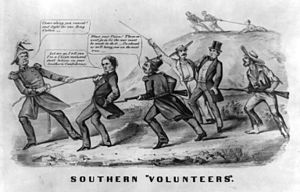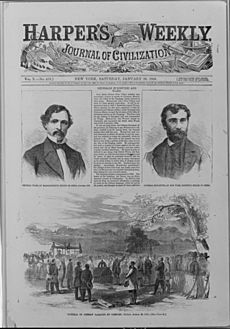Nueces massacre facts for kids
Quick facts for kids Nueces Massacre |
|||||||
|---|---|---|---|---|---|---|---|
| Part of the American Civil War | |||||||
 |
|||||||
|
|||||||
| Belligerents | |||||||
| Texas-German Unionists | |||||||
| Commanders and leaders | |||||||
| Hamilton Bee, James Duff, Colin McRae | Fritz Tegener | ||||||
| Strength | |||||||
| 96 | 61 | ||||||
| Casualties and losses | |||||||
| 2 dead, 18 wounded | 37 dead, unknown wounded and fled | ||||||
The Nueces Massacre, also called the Massacre on the Nueces, was a sad and violent event. It happened on August 10, 1862, in Kinney County, Texas, during the American Civil War. This event involved soldiers from the Confederate States of America and a group of German Texans.
Many German immigrants had moved to Central Texas, especially to a place called the Hill Country. These Germans often supported the Union side in the war. They also did not agree with slavery. Because of these feelings, the Confederate government put strict rules, called martial law, on Central Texas.
A group of these Germans tried to escape from the Hill Country. They wanted to go to Mexico and then to New Orleans, which was controlled by the Union. But Confederate soldiers found them near the Nueces River. The Germans were defeated, and many were killed. This event stopped open German resistance to the Confederacy in Texas. However, it also made many German-Texans very angry. Even today, people in the Hill Country still talk about what happened.
Contents
Why It Happened
Germans started moving to Texas as early as 1836. By 1860, about 20,000 Germans lived in Texas. Most of them were first-generation immigrants. They settled mostly in an area known as the Hill Country. This area included counties like Gillespie, Kerr, Kendall, Medina, and Bexar. People sometimes called this area the "German Belt."
Before the Civil War, Germans had different ideas about slavery and leaving the United States (secession). Some Germans owned enslaved people. A few even supported Texas leaving the Union. But most Germans didn't have strong feelings about slavery. A smaller group of Germans, however, were strongly against slavery. These included Germans called Achtundvierziger, or Forty-Eighters. They were often liberal and wanted more freedom. Many Forty-Eighters stayed loyal to the United States and opposed slavery.
Many Anglo-Texans who wanted to leave the Union did not like this. These disagreements grew when Texas left the United States in March 1861. The American Civil War then started on April 12, 1861.
German Texans and the War
When the war began, Germans seemed to stay out of the conflict. But Confederate officials worried about them. They saw the German population as a threat from within Texas. The strongest supporters of the Union were Tejanos (Texans of Mexican heritage) and German Texans. These groups lived in Central Texas and the Hill Country.
Confederate leaders had reasons for their suspicions. When Texas voted on leaving the Union, counties with many Germans voted against it. Some reports in early 1862 even said that German communities celebrated when the Union won battles. The Texas government also worried about local militias run by Germans.
One such group was the Union Loyal League. It was started by some Forty-Eighters. Historians still debate the group's true goal. Some say the Germans claimed it was to protect the Hill Country from Native Americans and outlaws. But Confederates believed the League was meant to support German Unionists. Confederate officers even thought the group planned to free Union soldiers from Camp Verde.
The Draft and Escape Plans
The Confederacy needed more soldiers. So, they started a draft, which meant people were forced to join the army. Many Germans did not want to fight against the Union. They objected to being drafted. This problem started in the spring of 1862 when the Confederacy began drafting Texans. The Confederate Conscription Act of 1862 made many Germans openly resist.
Because of this resistance, General Hamilton Bee sent Captain James Duff to Gillespie County. In late May 1862, Captain Duff put the area under martial law. While there, Captain Duff arrested and killed two Germans. This harsh treatment convinced many Germans to leave Texas.
Frederick "Fritz" Tegener and his Union Loyal League friends planned to escape. Their goal was to go to Mexico. From there, they hoped to reach New Orleans, which was controlled by the Union army.
The Escape and the Battle
Between August 1 and August 3, 1862, sixty-one German Texans left Turtle Creek. They were led by Fritz Tegener and headed southwest toward the Mexican border. Captain Duff learned about their plan. On August 3, 1862, he sent Lieutenant Colin McRae and about 96 soldiers to chase them.
After six days, on August 9, Lieutenant McRae and his men found the German Texans. They were in a small grassy area along the Nueces River. Lieutenant McRae then made a plan to attack later that night. He split his soldiers into two groups to surround the German camp.
Around 1:00 a.m. on August 10, 1862, the Confederates moved in. But their surprise attack didn't work perfectly. Two Germans who were outside the camp saw the Confederate soldiers. The Confederates fired at them, which warned the camp. The Germans fought back and stopped the first Confederate attack.
However, many Germans were scared and ran away. Historian Stanley McGowen believes that between twenty-three and twenty-eight Germans fled during the early morning. This meant the German group was much smaller. A second attack closer to dawn defeated the Germans. Most of the remaining German fighters either ran away (at least five, including Tegener), were badly hurt, or died.
After the Battle
The Confederates had 96 soldiers. They lost two soldiers and eighteen were wounded, including Lieutenant McRae. It was harder to know how many Germans were hurt or killed. In 1962, historian Robert Shook said thirty Germans were killed and twenty were wounded. A more recent study in 2003 by historian Randolph Campbell said 19 Germans died right away during the attacks.
But that was not the end of the German losses. After the battle, Confederate soldiers killed nine badly wounded Germans. Cavalry soldiers chased nine more Germans to the Rio Grande river. These fleeing Germans were also killed. In total, about thirty-seven Germans were killed. We don't know how many were wounded among those who ran away and survived.
Some Germans did survive the battle and the chase. These survivors either hid in Texas, escaped to Mexico or California, or later joined Union forces in New Orleans. They became part of the Union First Texas Cavalry.
The Nueces Massacre greatly affected the German community in Texas for the rest of the war. Even though other German Texans were very angry and spoke out, this event mostly ended open German support for the Union in Texas for the rest of the war.
What We Remember
When the war ended in 1865, Germans were some of the happiest people about the Union's victory. On August 10, 1866, a monument was built in Comfort, Texas. It is called the Treue der Union Monument, which means "Loyalty to the Union." This monument remembers those who died in the 1862 Nueces Massacre.
The bodies of those who died are buried at the monument site, except for those who drowned in the Rio Grande. This was the only monument built by local people to honor the Union in a former Confederate state.
Battle or Massacre?
People have argued about what to call the event: the "Battle of Nueces" or the "Nueces Massacre." This debate has gone on since the event itself. Recently, historian Stanley McGowen looked at both sides of the argument.
He points out that the Germans were well-armed. They were even able to push back a larger Confederate force at first. So, he agrees that the first fight could be called the Battle of the Nueces. But he also says that the killing of wounded Germans after the fight makes the name Nueces Massacre fitting.
No single name has been fully agreed upon. McGowen admits that the debate about what the Confederates and Germans did still continues among the families of those involved.




